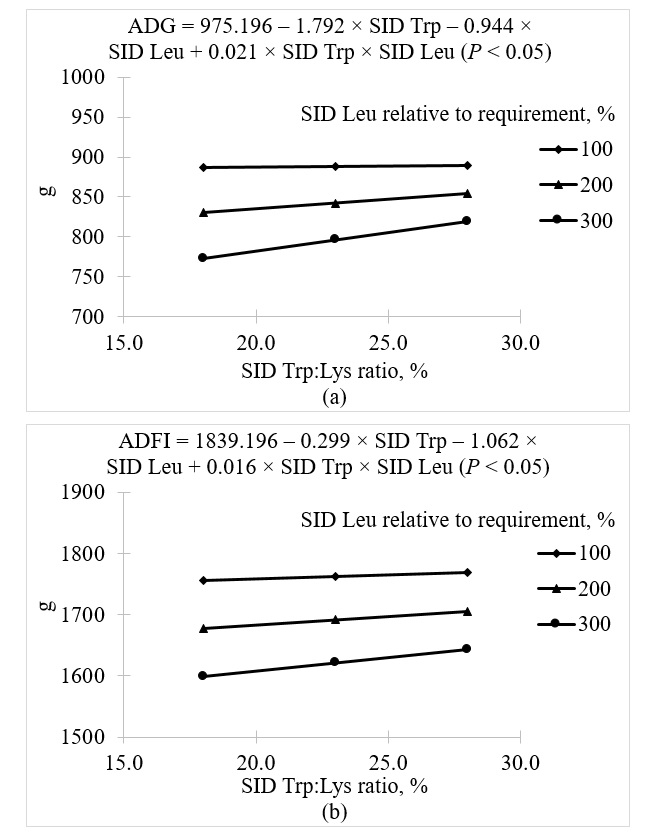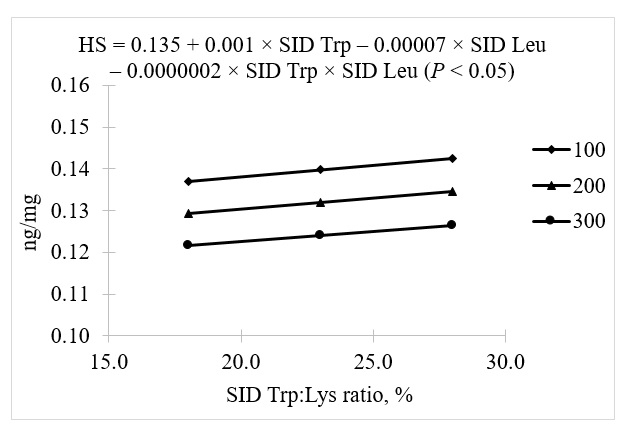Tryptophan is an indispensable AA that is often limiting for growth in pigs fed corn-soybean meal-based diets. Tryptophan may act as a regulator of feed intake by enhancing serotonin signaling in the brain, because Trp is a precursor for serotonin. High Trp intake increases feed intake, and this is partly attributed to increased serotonin synthesis. Availability of dietary Trp in the brain is considered the rate-limiting step in hypothalamic serotonin synthesis. However, to be transported into the brain, Trp competes with other large neutral AA such as Val, Leu, Ile, Tyr, and Phe for a common transporter (L-type AA transporter 1) to cross the blood-brain barrier.
Diets based on corn and corn co-products and sorghum and sorghum co-products are rich in Leu and excess dietary Leu reduces pig feed intake and growth performance. Excess dietary Leu may also reduce synthesis of serotonin in the brain. Excess Leu may prevent Trp from being transported from blood to brain, which may result in reduced availability of Trp for serotonin synthesis in the brain. As a consequence, it is possible that if dietary Leu is in excess of the requirement, extra dietary Trp may be needed.
Therefore, the objective of this experiment was to test the hypothesis that increased dietary Trp is needed in high-Leu diets for growing pigs to prevent drop in both plasma serotonin and hypothalamic serotonin concentrations and to maintain growth performance of animals.
Experimental Design
A total of 144 growing pigs (initial body weight: 28.2 ± 1.9 kg) were assigned to 9 dietary treatments in a randomized complete block design with 8 replicate pens per treatment. A basal diet based on corn, soybean meal, wheat, and barley was formulated to contain 100% of the requirement for standardized ileal digestible (SID) Leu. Two additional diets were formulated by adding crystalline L-Leu to the basal diet to increase the concentration of SID Leu to 200 or 300% of the requirement. These 3 diets were formulated to have a SID Trp:Lys ratio of 18%. Six additional diets were formulated by adding either 0.05% or 0.10% crystalline L-Trp to each of the 3 original diets. Thus, 9 diets were used in a 3 × 3 factorial with 3 levels of Leu (100, 200, or 300% of the SID requirement) and 3 levels of SID Trp (18, 23, or 28% SID Trp:Lys). Individual pig weights were recorded at the conclusion of the 21-d experiment and on the last day of the experiment, one pigs per pen was sacrificed and blood and hypothalamus samples were collected to measure plasma urea N, plasma serotonin, and hypothalamic serotonin concentrations.
Results
The ADG and ADFI were positively affected by increased dietary SID Trp, but negatively affected by increased dietary concentration of SID Leu (Table 1). However, the ADG and ADFI were positively affected by the interaction between SID Trp and SID Leu (Fig. 1). Hypothalamic serotonin was positively affected by increased dietary SID Trp, but negatively affected by increased dietary concentration of SID Leu. However, the hypothalamic serotonin was negatively affected by the interaction between SID Trp and SID Leu (Fig. 2).
Key Points
- Increased dietary Leu reduced ADG and ADFI, but Trp supplementation partially overcome the negative effect of excess dietary Leu.
- Hypothalamic serotonin concentration was decreased as dietary Leu increased as a consequence of reduced uptake of Trp, but hypothalamic serotonin concentration was increased as dietary Trp increased.
Table 1. Least squares means for growth performance, plasma urea N, and serotonin in plasma and hypothalamus of growing pigs fed diets with varying ratios between standardized ileal digestible (SID) Leu:Lys and SID Trp:Lys (as-fed basis)
|
SID Leu:Lys , %: |
100 |
200 |
300 |
|
||||||
|---|---|---|---|---|---|---|---|---|---|---|
|
SID Trp:Lys , %: |
18 |
23 |
28 |
18 |
23 |
28 |
18 |
23 |
28 |
SEM |
|
Growth performance |
|
|
|
|
|
|
|
|
|
|
|
ADG1, g/d |
867 |
898 |
852 |
845 |
869 |
905 |
750 |
815 |
777 |
61 |
|
ADFI2, g/d |
1,675 |
1,724 |
1,630 |
1,657 |
1,656 |
1,720 |
1,519 |
1,584 |
1,506 |
95 |
|
G:F3 |
0.52 |
0.52 |
0.52 |
0.51 |
0.52 |
0.53 |
0.49 |
0.51 |
0.51 |
0.02 |
|
Plasma urea N4, μg/mL |
8.8 |
7.4 |
7.9 |
8.6 |
7.9 |
8.3 |
7.6 |
8.9 |
8.1 |
1.0 |
|
Serotonin |
|
|
|
|
|
|
|
|
|
|
|
Plasma5, ng/mL |
62.8 |
40.1 |
68.8 |
57.2 |
53.6 |
41.1 |
67.8 |
59.7 |
39.7 |
19.1 |
|
Hypothalamus6, ng/mg |
0.139 |
0.138 |
0.142 |
0.128 |
0.132 |
0.136 |
0.122 |
0.126 |
0.125 |
0.006 |
|
s |
s |
s |
s |
s |
s |
s |
s |
s |
s |
s |
1Results indicated that ADG from d 0 to d 21 at different combinations of SID Trp and SID Leu could be described by the following model: 975.196 – 1.792 × SID Trp – 0.944 × SID Leu + 0.021 × SID Trp × SID Leu (P < 0.05).
2Results indicated that ADFI from d 0 to d 21 at different combinations of SID Trp and SID Leu could be described by the following model: 1839.196 – 0.299 × SID Trp – 1.062 × SID Leu + 0.016 × SID Trp × SID Leu (P < 0.05).
3Results indicated that G:F could not be predicted from dietary SID Trp or SID Leu.
4Results indicated that plasma urea N could not be predicted from dietary SID Trp or SID Leu.
5Results indicated that serotonin concentration in plasma could not be predicted from dietary SID Trp or SID Leu.
6Results indicated that serotonin concentration in hypothalamus at different combinations of SID Trp and SID Leu could be described by the following model: 0.135 + 0.001 × SID Trp – 0.00007 × SID Leu – 0.0000002 × SID Trp × SID Leu (P < 0.05).

Figure 1. Predicted values, based on the interaction between SID Trp and SID Leu (P < 0.05), for (a) average daily gain (ADG) and (b) average daily feed intake (ADFI) in growing pigs fed diets containing from 18 to 28% standardized ieal digestible (SID) Trp:Lys and from 100 to 300% SID Leu relative to the requirement.

Figure 2. Predicted values, based on the interaction between SID Trp and SID Leu (P < 0.05), for hypothalamic serotonin (HS) concentrations in growing pigs fed diets containing from 18 to 28% standardized ieal digestible (SID) Trp:Lys and from 100 to 300% SID Leu relative to the requirement.